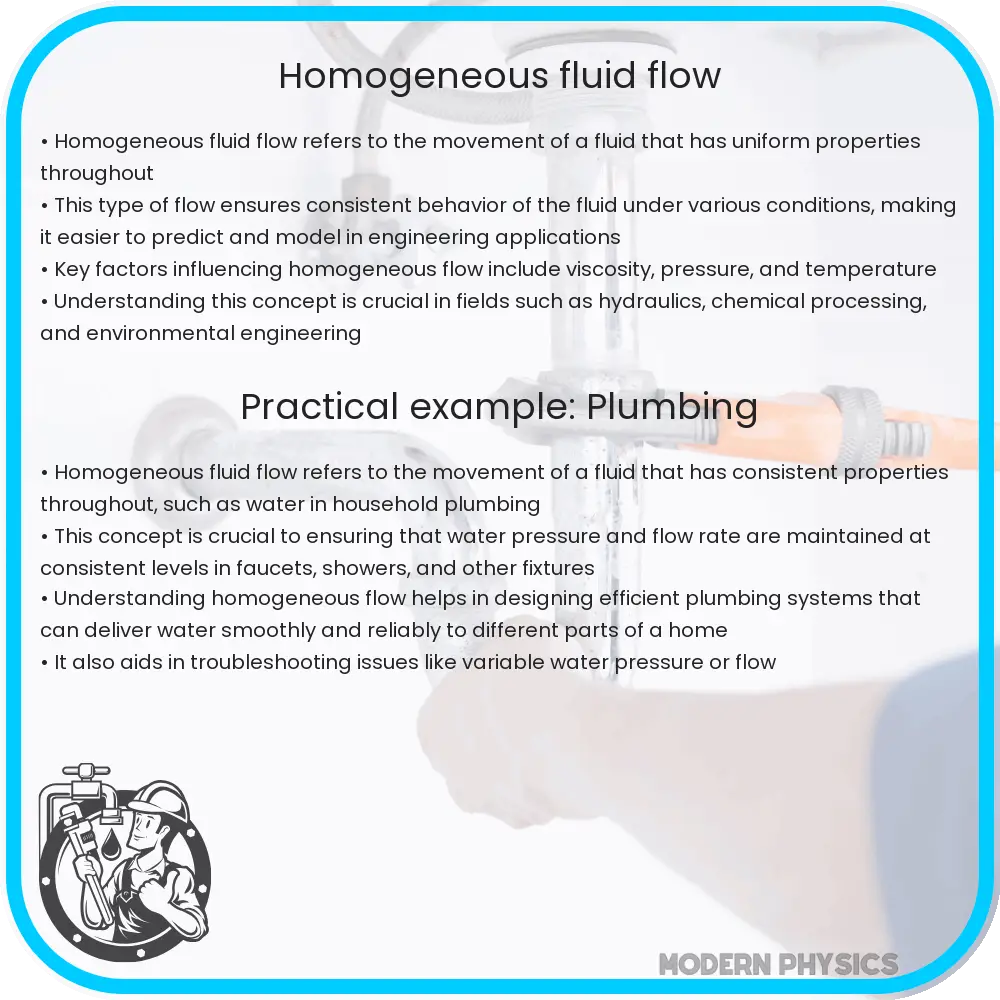Explore the efficiency, analysis, and applications of homogeneous fluid flow in engineering and environmental sustainability for optimal system design.

Understanding Homogeneous Fluid Flow
Homogeneous fluid flow is a fundamental concept in fluid dynamics, playing a pivotal role in various engineering and scientific applications. This type of flow occurs when a fluid’s properties, such as density, temperature, and composition, are uniform throughout the system. Such consistency ensures predictable and efficient flow patterns, essential for designing and optimizing numerous industrial processes.
Efficiency in Homogeneous Fluid Flow
The efficiency of homogeneous fluid flow is closely linked to its uniform properties. In systems like pipelines, HVAC (Heating, Ventilation, and Air Conditioning), and process engineering, maintaining a homogeneous flow minimizes turbulence and energy loss. This uniformity leads to reduced operational costs and enhanced system longevity, as consistent flow reduces wear and tear on mechanical components.
Analysis of Homogeneous Fluid Flow
Analyzing homogeneous fluid flow involves understanding the behavior of fluids under various conditions. Key parameters include velocity, pressure, and temperature distributions within the flow. Advanced computational tools like Computational Fluid Dynamics (CFD) are often employed to simulate and analyze these parameters, providing insights into flow behavior and aiding in system design and optimization.
One fundamental equation in fluid dynamics is the Bernoulli’s equation, which in its simplest form can be written as:
\[ P + \frac{1}{2} \rho v^2 + \rho gh = \text{constant} \]
where \( P \) is the fluid pressure, \( \rho \) the density, \( v \) the velocity, \( g \) the acceleration due to gravity, and \( h \) the height above a reference point.
Applications of Homogeneous Fluid Flow
Homogeneous fluid flow finds applications in numerous fields. In chemical engineering, it is crucial for the efficient operation of reactors and mixers, ensuring consistent chemical reactions. In the environmental sector, understanding homogeneous flow assists in pollution modeling and water treatment processes. Additionally, in the aerospace industry, homogeneous flow analysis is vital for the design of efficient and safe aircraft.
This flow type also plays a significant role in renewable energy, particularly in hydropower and wind energy sectors. Here, the predictability of homogeneous fluid flow aids in optimizing turbine design for maximum energy extraction.
In conclusion, homogeneous fluid flow is a key concept in fluid dynamics, offering efficiency and predictability in various industrial and scientific applications. Its analysis and understanding are crucial for the development and optimization of systems in a wide range of sectors.
Advanced Techniques in Homogeneous Fluid Flow Analysis
The study of homogeneous fluid flow has evolved with the advent of new technologies and methodologies. Advanced simulation techniques, such as CFD, now incorporate detailed thermodynamic and chemical kinetics models. These models enhance the precision of flow predictions, especially in complex industrial applications like combustion engines and chemical reactors. Additionally, the integration of machine learning algorithms with fluid dynamics simulations is opening new avenues for predicting flow behavior under varied conditions, further improving efficiency and system design.
Challenges and Solutions in Homogeneous Fluid Flow
Despite its advantages, achieving and maintaining homogeneous fluid flow poses challenges. In large-scale systems, maintaining uniform properties across the entire flow can be difficult due to external factors like temperature gradients and physical obstructions. To address these challenges, engineers employ techniques such as flow conditioning and mixing devices to ensure uniformity. Regular system monitoring and maintenance are also crucial to detect and rectify any deviations from homogeneous flow.
Environmental and Sustainable Aspects
Homogeneous fluid flow also plays a significant role in environmental sustainability. In water treatment, ensuring a uniform flow is vital for the effective removal of contaminants and the conservation of water resources. Similarly, in air pollution control systems, homogeneous flow aids in the efficient capture and neutralization of pollutants. The application of this concept in renewable energy systems, like wind farms and hydroelectric plants, further underscores its importance in sustainable development.
In the context of global climate change, optimizing fluid flow in industrial processes not only improves efficiency but also reduces energy consumption and greenhouse gas emissions. This alignment with environmental goals highlights the broader significance of homogeneous fluid flow beyond its immediate technical applications.
Conclusion
Homogeneous fluid flow is a cornerstone of modern fluid dynamics, deeply intertwined with efficiency, analysis, and application in various fields. Its significance spans from industrial processes to environmental conservation and sustainable energy production. Ongoing advancements in simulation and analysis techniques continue to enhance our understanding and utilization of this vital concept. As we face global challenges like climate change and resource conservation, the principles of homogeneous fluid flow will undoubtedly play a crucial role in developing innovative and sustainable solutions for the future.
